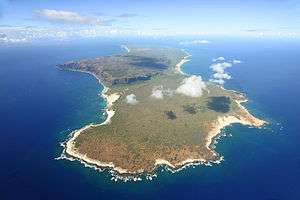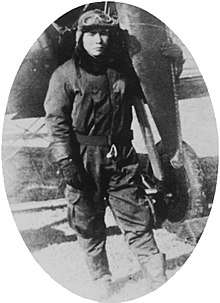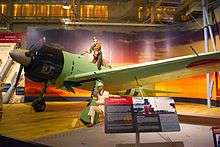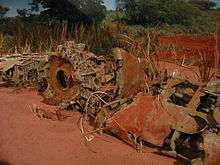Niihau incident
The Niʻihau incident occurred on December 7–13, 1941, when Imperial Japanese Navy Air Service pilot Shigenori Nishikaichi (西開地 重徳, Nishikaichi Shigenori) crash-landed his Zero on the Hawaiian island of Niʻihau after participating in the attack on Pearl Harbor. The Imperial Japanese Navy had designated Niʻihau as an uninhabited island for damaged aircraft to land and await rescue.
| Ni’ihau incident | |||
|---|---|---|---|
| Part of the Pacific Theater of World War II | |||
 Aerial view of Niʻihau looking southwestward from the north, where the incident took place | |||
| Date | December 7–13, 1941 | ||
| Location | Ni’ihau, Hawaii Territory, U.S. | ||
| Resulted in | See Conclusion. | ||
| Parties to the civil conflict | |||
| Lead figures | |||
| Number | |||
| |||
| Casualties and losses | |||
| |||
The pilot shared information about the Pearl Harbor attack with island locals of Japanese descent. Native Hawaiian residents were initially unaware of the attack, but apprehended Nishikaichi when the gravity of the situation became apparent. The pilot then sought and received the assistance of the three Hawaiian locals of Japanese descent on the island in overcoming his captors, finding weapons, and taking several hostages. Eventually, Nishikaichi was killed by Niihauans Benehakaka "Ben" Kanahele and his wife Kealoha "Ella" Kanahele;[1] Ben Kanahele was wounded in the process, and one of Nishikaichi's supporters, Yoshio Harada, committed suicide.
Ben Kanahele was decorated for his part in stopping the takeover, but Ella Kanahele received no official recognition.[1]
Background
Niʻihau, the westernmost and second smallest of the primary Hawaiian Islands, has been privately owned by the Robinsons, a white kamaʻaina family, since 1864. At the time of the incident, it had 136 inhabitants, almost all of whom were Native Hawaiians whose first language was Hawaiian. In 1941 the owner was Aylmer Robinson, a Harvard University graduate who was fluent in Hawaiian. Robinson ran the island without interference from any government authority, and although he lived on the nearby island of Kauaʻi, he made weekly visits by boat to Niʻihau. The island was accessible only with Robinson’s permission, which was almost never given except to friends or relatives of Niihauans. The handful of non-Native residents included three of Japanese ancestry: Ishimatsu Shintani, a first-generation immigrant from Japan (Issei) and Hawaiian-born Nisei Yoshio Harada and his wife Irene Harada (an Issei), all of whom were involved in the incident.
Prior to the Pearl Harbor attack, the Imperial Japanese Navy had designated Niʻihau, mistakenly believed to be uninhabited, as a location for aircraft damaged in the attack to land. Pilots were told they could wait on the island until they were rescued by submarine.[2][3][4]
Incident
Nishikaichi crash-lands

On December 7, 1941, Airman First Class Shigenori Nishikaichi (c. 1919 – December 13, 1941), who had taken part in the second wave of the Pearl Harbor attack, crash-landed his battle-damaged aircraft, an A6M2 Zero "B11-120" from the carrier Hiryu, in a Niʻihau field near where Hawila Kaleohano (1912–1986), a native Hawaiian, was standing.[5] Kaleohano was unaware of the attack at Pearl Harbor, but knew from newspapers that the relationship between the U.S. and Japan was poor due to Japanese expansionism and the U.S. oil embargo on Japan. Recognizing Nishikaichi and his plane as Japanese, Kaleohano thought it prudent to relieve the pilot of his pistol and papers before the dazed airman could react. He and the other Hawaiians who gathered about treated the pilot with courtesy and the traditional Hawaiian hospitality, even throwing a party for him later that Sunday afternoon. However, the Hawaiians could not understand Nishikaichi, who spoke only Japanese with a limited amount of English. They sent for Issei Ishimatsu Shintani, who was married to a native Hawaiian, to translate.
Having been briefed on the situation beforehand and approaching the task with evident distaste, Shintani exchanged just a few words with the pilot and departed without explanation. The puzzled Hawaiians then sent for Yoshio Harada, who was born in Hawaiʻi of Japanese ancestry, and his wife Irene (an Issei), both of whom constituted the remainder of the Niʻihau population of Japanese ancestry. Nishikaichi informed Harada of the attack on Pearl Harbor, a revelation Harada thought prudent not to share with the non-Japanese natives. Nishikaichi desperately wanted his papers returned, which he had been told should by no means fall into American hands, but Kaleohano refused to return them. The Haradas decided to assist Nishikaichi in retrieving his papers and escaping.
News of the Pearl Harbor attack

Niʻihau had neither electricity nor telephones, but later that night, the Hawaiians heard a radio report about the Pearl Harbor attack on a battery-operated radio. The Hawaiians confronted the pilot, and this time Harada translated what was said about the attack. The owner of the island, Aylmer Robinson, was scheduled to arrive on his regular weekly trip from Kauaʻi, a much larger island just 17 miles (27 km) away, the next morning. It was decided that the pilot would return to Kauaʻi with Robinson.
Robinson did not arrive on Monday because the U.S. military had instituted a ban on boat traffic in the islands within hours of the attack. Nor did he arrive in the following days. The Niʻihauans, knowing nothing of the ban, were puzzled and very uneasy that the normally dependable Robinson had not been seen since the attack. The Haradas' request to have the pilot stay with them was agreed to, but with a contingent of four guards. There was now ample opportunity for the Haradas to converse with Nishikaichi.
At four o'clock on December 12, Shintani approached Kaleohano in private with about $200 in cash, which was a huge sum for the Niʻihauans. He tried to buy the pilot's papers, but Kaleohano again refused. Shintani unhappily departed, saying there would be trouble if the papers were not returned, that it was a matter of life and death. Harada and Nishikaichi, not waiting for Shintani's return, attacked the lone guard who had been posted outside the Harada residence, while Irene Harada, Yoshio's wife, played music on a phonograph to cover up the sounds of the struggle. Three other guards were stationed to watch the Harada residence, but were not present at the time of the attack. The guard was locked in a warehouse, where Harada acquired a shotgun and the pilot's pistol that had previously been stored there. Thus armed, they proceeded to Kaleohano's house. Having parted from Shintani only five or ten minutes before, Kaleohano was in his outhouse when he saw Harada and Nishikaichi coming, together with a 16-year-old captive that they prodded along with a gun. Kaleohano stayed hidden in the outhouse, and the conspirators, unable to find him, turned their attention to the nearby plane. Seeing his opportunity, Kaleohano burst out of the outhouse. He heard "Stop! Stop!" and the boom of a shotgun as he ran for his life. Kaleohano alerted the residents of the nearby village, warning them to evacuate. Many could not believe that their good friend and neighbor, Harada, whom they knew so well and who had been living among them for almost three years, could do the things that Kaleohano relayed. When the captive guard escaped and reached the village, the residents fled—the women and children to caves, thickets, and distant beaches.
Kaleohano's midnight run

Robinson had come to know that there was trouble on Niʻihau because the Niihauans had flashed signals toward Kauaʻi with kerosene lanterns and reflectors. Meanwhile, Nishikaichi unsuccessfully attempted to make contact with the Japanese military using the downed aircraft's radio. With the help of Harada and one of their Hawaiian captives, they removed at least one of the two 7.7 mm machine guns on board the Japanese fighter plane with some ammunition, torched the plane, and proceeded to Kaleohano's house, which they set ablaze at about 3 a.m. in a final effort to destroy Nishikaichi's papers, which included maps, radio codes, and Pearl Harbor attack plans.[7]
Conclusion
During the night, another Niʻihau resident, Kaahakila Kalimahuluhulu, known as Kalima, had also been taken captive. He was released to help search for Kaleohano, who had escaped with Nishikaichi's papers. Instead, Kalima enlisted his friend Benehakaka "Ben" Kanahele to sneak back in the darkness to steal the machine guns and ammunition. That morning, Saturday, December 13, Harada and Nishikaichi captured Kanahele[8] and his wife, Kealoha "Ella" Kanahele (1907–1974), also natives of the island.[5] They ordered Kanahele to find Kaleohano, keeping Ella as a hostage. Kanahele knew that Kaleohano was rowing toward Kauaʻi but made a pretense of looking for him. He soon became concerned about Ella and returned to her. Nishikaichi realized he was being deceived. Harada told Kanahele that the pilot would kill him and everyone in the village if Kaleohano was not found.[7]
Kanahele and his wife, taking advantage of the fatigue and discouragement of his two captors, leapt at them as the pilot handed the shotgun to Harada. When Nishikaichi pulled his pistol out of his boot, Ella Kanahele grabbed his arm and brought it down. Harada pulled her off the pilot, who then shot Ben Kanahele three times: in the groin, stomach, and upper leg. However, Kanahele was still able to pick up Nishikaichi, in the same manner that he hoisted the sheep that were commercially raised on the island, and hurl the pilot into a stone wall. Ella Kanahele then bashed him in the head with a rock, and Ben slit his throat with his hunting knife. Harada then turned the shotgun on himself, committing suicide.[9]
After the incident, Ella Kanahele went for help, dropping the shotgun and the pistol on the way. (About five years later, a flood washed the shotgun into a wall where it was found by islanders. The pistol and one of the machine guns were never found.) Ben Kanahele was taken to Waimea Hospital on Kauaʻi to recuperate;[10] he was awarded the Medal for Merit and the Purple Heart, but Ella did not receive any official recognition.[11]
The next afternoon, December 14, the military authorities, the six Hawaiians who had rowed to Kauaʻi, and Robinson arrived together.
Post-incident
The grieving Irene Harada and Ishimatsu Shintani were taken into custody. Shintani was sent to an internment camp and later rejoined his family on Niʻihau, where he attained U.S. citizenship in 1960.[11]
Irene Harada was imprisoned for 31 months, being released in June 1944. She was never charged with treason, nor any other crime resulting from the incident. She maintained her innocence, but added in a 1992 interview with Japanese television that she felt sorry for the pilot and wanted to help him.[12] She moved to the island of Kaua’i. Mitsuo Fuchida, a naval commander during the attack on Pearl Harbor and later a Christian evangelist who settled in the U.S., visited her after his short trip to Ni'ihau.[13]
Composer R. Alex Anderson was inspired by the incident to compose "They Couldn't Take Niihau, Nohow!" It was played on August 15, 1945, when Kanahele was decorated for the part he played in defending his country by Lieutenant General Robert C. Richardson at Army Headquarters, Fort Shafter, Honolulu.[14][15]
Repercussions
Historian Gordon Prange notes that it was "the rapidity with which the three resident Japanese went over to the pilot's cause" which troubled the Hawaiians. "The more pessimistic among them cited the Niʻihau incident as proof that no one could trust any Japanese, even if an American citizen, not to go over to Japan if it appeared expedient."[16] Novelist William Hallstead argues that the Niʻihau incident had an influence on decisions leading to the Japanese American internment on the continental United States. According to Hallstead, the behavior of Shintani and the Haradas were included in an official Navy report dated January 26, 1942. Its author, Navy Lieutenant C. B. Baldwin, wrote, "The fact that the two Niʻihau Japanese who had previously shown no anti-American tendencies went to the aid of the pilot when Japanese domination of the island seemed possible, indicate[s] [the] likelihood that Japanese residents previously believed loyal to the United States may aid Japan if further Japanese attacks appear successful."[17] Despite this, the Japanese population in Hawaii was largely spared from mass internment throughout the war due to economic concerns (more than one-third of Hawaii's total population were Japanese Americans who comprised "over 90 percent of the carpenters, nearly all of the transportation workers, and a significant portion of the agricultural laborers").[18] The territory was however put under martial law and lookouts were established, making internment not necessary from a security perspective.
Legacy
Memorial

The coastal town of Hashihama, Imabari, Ehime Prefecture, Japan erected a 12-foot granite cenotaph in their native son's honor when it was still believed that he had perished the day of the attack, December 7, 1941. For many years Nishikaichi's remains were that of an unknown Japanese soldier, and it was not until 1956 that the circumstances of his death were revealed to his family and his ashes claimed by them. Engraved on the column is what was believed at the time: "Having expended every effort, he achieved the greatest honor of all by dying a soldier's death in battle, destroying both himself and his beloved plane... His meritorious deed will live forever."[19] In June 2017 the pilot's nafuda, a set of seven wooden sticks that carried the names of Airman 1st Class Nishikaichi's colleagues, the identifying markings of his Zero, and his administrative command, were returned to his family in Japan.[20]
Museum exhibit and controversy
Both the remains of Nishikaichi's Zero and those of the old tractor he used to travel to the boat landing are on permanent display at the Pacific Aviation Museum Pearl Harbor on Ford Island in Pearl Harbor. A Japanese-American group in Hawai’i criticized the original design of the museum display. Threatening to have federal funds withheld, they demanded that the museum remove mention of the Haradas from the display. The Robinson family was very unhappy with the censorship of the information about the Haradas, especially since they had donated the aircraft and tractor pieces based on what they were told about how the display would read. The exhibit does state that Yoshio Harada committed suicide after the incident but does not mention his wife.[21]
Movie depiction
A film entitled Enemy Within[22] was released in theaters on April 19, 2019.[23] The film logline is "When a Japanese pilot crash-lands on the tiny remote Hawaiian island of Ni'ihau, he is met with courtesy and traditional Hawaiian hospitality from the locals—until they discover he was part of the recent attack on Pearl Harbor."[22]
Notes
- merit-purple-heart-1891-1962/123 NI'IHAU INCIDENT – Benehakaka "Ben" Kanahele – WWII, Medal for Merit, Purple Heart (1891–1962) Archived 2014-04-07 at the Wayback Machine, by Duane Vachon, The Hawaii Reporter; published June 30, 2013; retrieved July 5, 2014
- Hallstead, William (November 13, 2000). "The Niihau Incident". HistoryNet. Archived from the original on November 10, 2019. Retrieved November 10, 2019.
- "Remembering Pearl Harbor: the Ni'ihau Incident". Pieces of History. December 6, 2018. Archived from the original on November 10, 2019. Retrieved November 10, 2019.
- "The Niihau Zero". Air & Space Magazine. Archived from the original on 2019-11-10. Retrieved 2019-11-10.
- Lord, Walter (1957). Day of Infamy. Henry Holt and Company. pp. 188–91. ISBN 0-8050-6803-1.
- Pacific Aviation Museum – Mistubishi A6M2 Zero – R.Costick, Pacific Aviation Museum, 5 Mar 2007, archived from the original on 2 December 2015, retrieved 7 Nov 2011
- "Pearl Harbor Japanese Aircraft Crash Sites : the Ni'ihau Zero: Part 5". Archived from the original on 2010-10-29. Retrieved 2014-06-29.
- The surname "kanahele" is composed of "ka," the definite article, and "nahele," meaning "forest." (Dictionary translation.) Kanahele is a common surname for many families who trace their ancestry to Niʻihau.
- Malkin, Michele (2004). In Defense of Internment: The Case for 'Racial Profiling' in World War II and the War on Terror. Regnery Publishing. p. 4. ISBN 9780895260512. Retrieved 10 December 2012.
Ben Kanahele.
- Beekman 1998, p. 89.
- Slackman, Michael (1990). Target Pearl Harbor. University of Hawaii Press. p. 231. ISBN 9780824813789.
Ben Kanahele.
- TBS (Tokyo Broadcasting System) interview of Irene Harada on Broadcaster, approximately 1992
- Shinsato, Douglas T. and Tadanori Urabe, "For That One Day: The Memoirs of Mitsuo Fuchida, Commander of the Attack on Pearl Harbor," eXperience, inc., Kamuela, Hawaii, 2011. ISBN 978-0-9846745-0-3, p. 294
- Beekman 1998, p. 105.
- "They Couldn't Take Niihau No-how". HUAPALA Hawaiian Music and Hula Archives. Archived from the original on 15 November 2016. Retrieved 24 September 2016.
- Prange 1962, pp. 375–77.
- Beekman 1998, p. 112.
- Takaki, Ronald T. "A Different Mirror: A History of Multicultural America". Boston: Little, Brown. 1993. Print, p. 378.
- Beekman 1998, p. 96.
- "Archived copy". Archived from the original on 2017-07-03. Retrieved 2017-07-03.CS1 maint: archived copy as title (link)
- Jones, Syd, Niihau Zero: The Unlikely Drama of Hawaii's Forbidden Island Prior to, During, and After the Pearl Harbor Attack, JBJ Delta Charlie LC/Signum Ops, Merritt Island, Florida, 2014
- "Enemy Within". Archived from the original on 2019-07-13. Retrieved 2019-11-10 – via www.imdb.com.
- "Archived copy". Archived from the original on 2019-04-02. Retrieved 2019-04-02.CS1 maint: archived copy as title (link)
References
- Beekman, Allan (1998) [1982]. The Niihau Incident. Honolulu, HI: Heritage Press of Pacific. ISBN 0-9609132-0-3.CS1 maint: ref=harv (link)
- Clark, Blake (1942). Remember Pearl Harbor!. New York: Modern Age Books. Archived from the original on 2008-12-04.CS1 maint: ref=harv (link)
- Jones, Syd (2014). 'Niihau Zero: The Unlikely Drama of Hawaii's Forbidden Island Prior to, During, and After the Pearl Harbor Attack. Merritt Island, Florida: JBJ Delta Charlie LC/Signum Ops.
- Prange, Gordon W (1962). December 7, 1941: The Day the Japanese Attacked Pearl Harbor. New York: McGraw Hill.CS1 maint: ref=harv (link)
- Shinsato, Douglas T. and Tadanori Urabe, For That One Day: The Memoirs of Mitsuo Fuchida, Commander of the Attack on Pearl Harbor,' eXperience, inc., Kamuela, Hawaii, 2011. ISBN 978-0-9846745-0-3
Further reading
- Frank, Richard B (July 2009). "Zero Hour on Niihau". World War II. Weider History Group. 24 (2): 54–61. ISSN 0898-4204.
- East Wind, Rain, a 2006 historical novel about the incident, by Caroline Paul.
- Hallstead, William. (Jan. 1, 2000) "The Niihau Incident." World War II 14.5
- Incident on Niihau Island Jason Bellows Updated December 7, 2015
- Stepien, Edward R. (1988) [1984]. "Appendix B: The Battle of Niʻihau". Niʻihau, A Brief History. 2. Honolulu: Center for Pacific Islands Studies, School of Hawaiian, Asian, & Pacific Studies, University of Hawaii at Manoa. pp. 198–210.
External links
| Wikimedia Commons has media related to Niihau Incident. |
- The NISHIKAICHI/NI'IHAU Zero, Part 1: The Missing Machine Gun Mystery! at j-aircraft.com
- The NISHIKAICHI/NI'IHAU Zero, Part 2: Other NI'IHAU Artifacts at j-aircraft.com
- The NISHIKAICHI/NI'IHAU Zero, Part 3: More NI'IHAU Zero Artifacts at j-aircraft.com